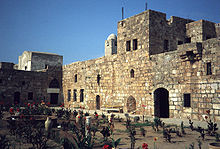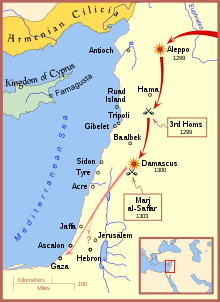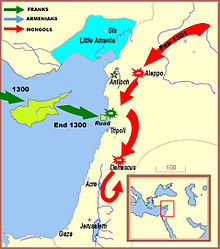
Jacques de Molay, also spelled "Molai", was the 23rd and last grand master of the Knights Templar, leading the order sometime before 20 April 1292 until it was dissolved by order of Pope Clement V in 1312. Though little is known of his actual life and deeds except for his last years as Grand Master, he is one of the best known Templars.

Hethum II, also known by several other romanizations, was king of the Armenian Kingdom of Cilicia, ruling from 1289 to 1293, 1295 to 1296 and 1299 to 1303, while Armenia was a subject state of the Mongol Empire. He abdicated twice in order to take vows in the Franciscan order, while still remaining the power behind the throne as "Grand Baron of Armenia" and later as Regent for his nephew. He was the son of Leo II of Armenia and Kyranna de Lampron, and was part of the Hethumid dynasty, being the grandson of Hethum I, who had originally submitted Cilicia to the Mongols in 1247. He was assassinated with his nephew and successor Leo III by the Mongol general Bilarghu, who himself was later executed for this by the Mongol Ilkhan ruler Öljaitü.

Arwad, the classical Aradus, is a town in Syria on an eponymous island in the Mediterranean Sea. It is the administrative center of the Arwad Subdistrict (nahiyah), of which it is the only locality. It is the only inhabited island in Syria. It is located 3 km (1.9 mi) from Tartus, Syria's second-largest port.

Mahmud Ghazan was the seventh ruler of the Mongol Empire's Ilkhanate division in modern-day Iran from 1295 to 1304. He was the son of Arghun, grandson of Abaqa Khan and great-grandson of Hulegu Khan, continuing a long line of rulers who were direct descendants of Genghis Khan. Considered the most prominent of the il khans, he is perhaps best known for converting to Islam and meeting Imam Ibn Taymiyya in 1295 when he took the throne, marking a turning point for the dominant religion of the Mongols in West Asia: Iran, Iraq, Anatolia, and the South Caucasus.
Amalric, Lord of Tyre, also called Amalric of Lusignan or Amaury de Lusignan was a prince and statesman of the House of Lusignan, a younger son of King Hugh III of Cyprus and Isabella of the House of Ibelin. He was given the title of Lord of Tyre in 1291, shortly before the city of Tyre fell to the Mamluks of Egypt. He is often but incorrectly called the Prince of Tyre.
Mulay, Mûlay, Bulay was a general under the Mongol Ilkhanate ruler Ghazan at the end of the 13th century. Mulay was part of the 1299–1300 Mongol offensive in Syria and Palestine, and remained with a small force to occupy the land after the departure of Ghazan. He also participated in the last Mongol offensive in the Levant in 1303. His name has caused confusion for some historians, because of its similarity with that of the contemporary Grand Master of the Knights Templar, Jacques de Molay.

Starting in the 1240s, the Mongols made repeated invasions of Syria or attempts thereof. Most failed, but they did have some success in 1260 and 1300, capturing Aleppo and Damascus and destroying the Ayyubid dynasty. The Mongols were forced to retreat within months each time by other forces in the area, primarily the Egyptian Mamluks. The post-1260 conflict has been described as the Mamluk–Ilkhanid War.

The Battle of Wadi al-Khaznadar, also known as the Third Battle of Homs, was a Mongol victory over the Mamluks in 1299.

Guillaume de Villaret, was the twenty-fourth Grand Master of the Knights Hospitaller, a position he held from 1296 until 1305, succeeding Odon de Pins. He was succeeded by his nephew, Foulques de Villaret, whose career he had done much to advance.

Hayton of Corycus was a medieval Armenian nobleman, monk and historiographer.

Several attempts at a Franco-Mongol alliance against the Islamic caliphates, their common enemy, were made by various leaders among the Frankish Crusaders and the Mongol Empire in the 13th century. Such an alliance might have seemed an obvious choice: the Mongols were already sympathetic to Christianity, given the presence of many influential Nestorian Christians in the Mongol court. The Franks—Western Europeans, and those in the Levantine Crusader states—were open to the idea of support from the East, in part owing to the long-running legend of the mythical Prester John, an Eastern king in an Eastern kingdom who many believed would one day come to the assistance of the Crusaders in the Holy Land. The Franks and Mongols also shared a common enemy in the Muslims. However, despite many messages, gifts, and emissaries over the course of several decades, the often-proposed alliance never came to fruition.
Jean II de Giblet was a Christian prince of the House of Giblet, an area of the Holy Land, in the 13th-14th century. His family used to be located in the fief of Cerep in Antioch, before the area was taken by the Mamluks. He was married to Marguerite du Plessis.
Isol the Pisan, also known as Ciolo Bofeti di Anastasio or Zolus Bofeti de Anestasio, was an Italian merchant, diplomat, and military leader. For some time he resided at the court of the Mongol Ilkhan, Ghazan, in Persia, rising to become his ambassador or liaison to the Kingdom of Cyprus. His high status at Ghazan's court may stem from his being the godfather of Öljeitü at the latter's baptism.

Mongol raids into Palestine took place towards the end of the Crusades, following the temporarily successful Mongol invasions of Syria, primarily in 1260 and 1300. Following each of these invasions, there existed a period of a few months during which the Mongols were able to launch raids southward into Palestine, reaching as far as Gaza.
Kutlushah, Kutlusha or Qutlughshah, was a general under the Mongol Ilkhanate ruler Ghazan at the end the 13th century. He was particularly active in the Christian country of Georgia and especially during the Mongol invasion of Syria, until his ignominious defeat in 1303 led to his banishment. He was killed during the conquest of Gilan in 1307.

The Fall of Tripoli was the capture and destruction of the Crusader state, the County of Tripoli, by the Muslim Mamluks. The battle occurred in 1289 and was an important event in the Crusades, as it marked the capture of one of the few remaining major possessions of the Crusaders. The event is represented in a rare surviving illustration from a now fragmentary manuscript known as the 'Cocharelli Codex', thought to have been created in Genoa in the 1330s. The image shows the countess Lucia, Countess of Tripoli and Bartholomew, Bishop of Tortosa sitting in state in the centre of the fortified city, and Qalawun's assault in 1289, with his army depicted massacring the inhabitants fleeing to boats in the harbour and to the nearby island of St Thomas.
Nerses Balients, also Nerses Balienc or Nerses Bagh'on, was a Christian Armenian monk of the early 14th century. He is mainly known for writing a history of the Kingdom of Cilician Armenia. Though his works are regarded by modern scholars as a valuable source from the time period, they are also regarded as frequently unreliable.

Mongol Armenia or Ilkhanid Armenia refers to the period beginning in the early-to-mid 13th century during which both Zakarid Armenia and the Armenian Kingdom of Cilicia became tributary and vassal to the Mongol Empire and the successor Ilkhanate. Armenia and Cilicia remained under Mongol influence until around 1335.

The fall of Outremer describes the history of the Kingdom of Jerusalem from the end of the last European Crusade to the Holy Land in 1272 until the final loss in 1302. The kingdom was the center of Outremer—the four Crusader states—formed after the First Crusade in 1099 and reached its peak in 1187. The loss of Jerusalem in that year began the century-long decline. The years 1272–1302 are fraught with many conflicts throughout the Levant as well as the Mediterranean and Western European regions, and many Crusades were proposed to free the Holy Land from Mamluk control. The major players fighting the Muslims included the kings of England and France, the kingdoms of Cyprus and Sicily, the three Military Orders and Mongol Ilkhanate. Traditionally, the end of Western European presence in the Holy Land is identified as their defeat at the Siege of Acre in 1291, but the Christian forces managed to hold on to the small island fortress of Ruad until 1302.
Barthélemy de Quincy was Marshal of the Knights Templar during the mastership of Jacques de Molay.














